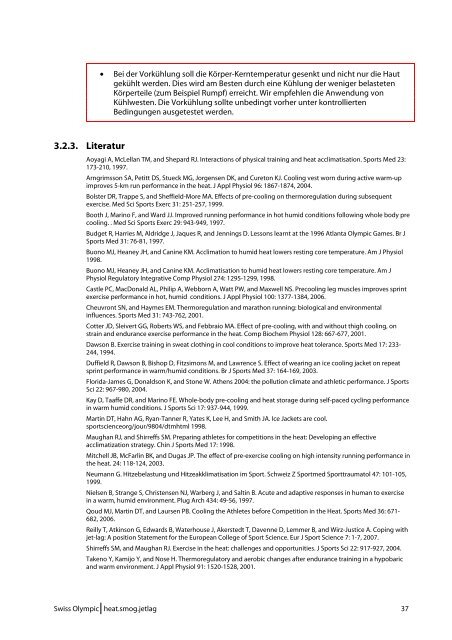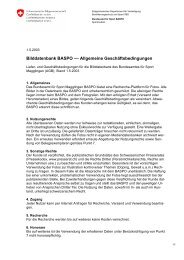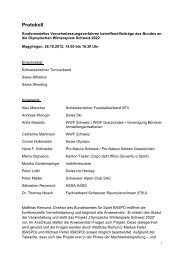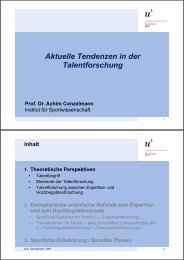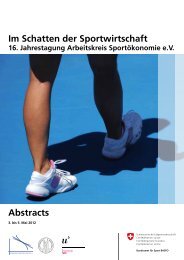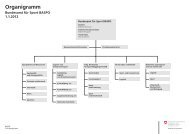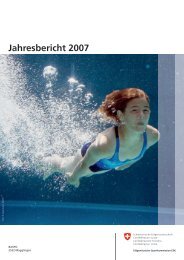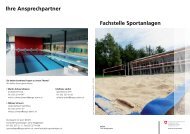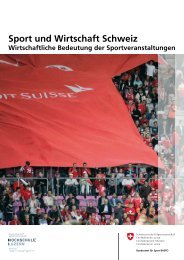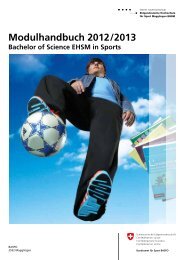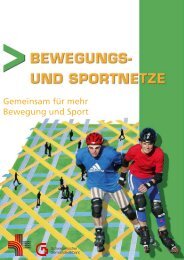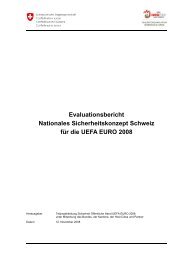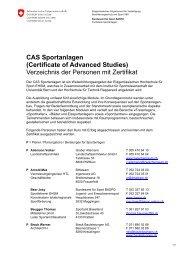heat.smog.jetlag - Bundesamt für Sport BASPO - admin.ch
heat.smog.jetlag - Bundesamt für Sport BASPO - admin.ch
heat.smog.jetlag - Bundesamt für Sport BASPO - admin.ch
Sie wollen auch ein ePaper? Erhöhen Sie die Reichweite Ihrer Titel.
YUMPU macht aus Druck-PDFs automatisch weboptimierte ePaper, die Google liebt.
3.2.3. Literatur<br />
• Beider Vorkühlung soll dieKörper-Kerntemperatur gesenkt und ni<strong>ch</strong>tnur die Haut<br />
gekühlt werden. Dies wird am Bestendur<strong>ch</strong> eine Kühlung der wenigerbelasteten<br />
Körperteile (zum Beispiel Rumpf) errei<strong>ch</strong>t. Wir empfehlendie Anwendungvon<br />
Kühlwesten. Die Vorkühlung sollte unbedingt vorher unter kontrollierten<br />
Bedingungenausgetestetwerden.<br />
Aoyagi A, McLellan TM, and ShepardRJ. Interactions of physical training and<strong>heat</strong>acclimatisation.<strong>Sport</strong>sMed 23:<br />
173-210, 1997.<br />
Arngrimsson SA, Petitt DS,StueckMG, JorgensenDK, and CuretonKJ. Coolingvest worn during active warm-up<br />
improves5-km runperformance in the <strong>heat</strong>. JAppl Physiol 96: 1867-1874, 2004.<br />
BolsterDR, Trappe S, and Sheffield-More MA. Effects of pre-cooling on thermoregulation during subsequent<br />
exercise.Med Sci <strong>Sport</strong>s Exerc 31:251-257, 1999.<br />
Booth J, MarinoF,and Ward JJ. Improved runningperformance in hot humid conditions following whole body pre<br />
cooling. .Med Sci<strong>Sport</strong>s Exerc 29:943-949, 1997.<br />
Budget R, Harries M, Aldridge J, Jaques R, and Jennings D. Lessons learnt at the 1996 Atlanta Olympic Games. Br J<br />
<strong>Sport</strong>s Med 31: 76-81, 1997.<br />
Buono MJ, Heaney JH, and Canine KM. Acclimation to humid <strong>heat</strong> lowers resting core temperature. Am JPhysiol<br />
1998.<br />
Buono MJ, Heaney JH, and Canine KM. Acclimatisation to humid <strong>heat</strong> lowers resting core temperature. Am J<br />
Physiol Regulatory Integrative Comp Physiol 274: 1295-1299, 1998.<br />
Castle PC, MacDonald AL, Philip A, Webborn A, Watt PW, andMaxwell NS.Precooling leg musclesimprovessprint<br />
exercise performance in hot, humid conditions. JAppl Physiol 100: 1377-1384, 2006.<br />
Cheuvront SN, and Haymes EM. Thermoregulation andmarathonrunning:biological and environmental<br />
influences. <strong>Sport</strong>s Med 31: 743-762, 2001.<br />
Cotter JD, Sleivert GG, RobertsWS, andFebbraio MA. Effect of pre-cooling, with and withoutthigh cooling, on<br />
strain and endurance exercise performance in the<strong>heat</strong>. Comp Bio<strong>ch</strong>em Physiol 128: 667-677, 2001.<br />
Dawson B. Exercise training in sweat clothing in cool conditions to improve<strong>heat</strong>tolerance. <strong>Sport</strong>s Med 17: 233-<br />
244,1994.<br />
Duffield R, Dawson B, Bishop D, Fitzsimons M, and Lawrence S. Effect of wearing an ice cooling jacket on repeat<br />
sprint performance in warm/humid conditions. Br J<strong>Sport</strong>s Med 37: 164-169, 2003.<br />
Florida-James G, Donaldson K, and Stone W. Athens 2004: thepollution climateand athletic performance. J<strong>Sport</strong>s<br />
Sci 22: 967-980, 2004.<br />
Kay D, Taaffe DR, and Marino FE. Whole-bodypre-cooling and <strong>heat</strong> storage during self-paced cycling performance<br />
in warm humid conditions. J<strong>Sport</strong>s Sci 17: 937-944, 1999.<br />
Martin DT, Hahn AG, Ryan-Tanner R, Yates K, Lee H, and Smith JA. Ice Jacketsare cool.<br />
sportscienceorg/jour/9804/dtmhtml 1998.<br />
Maughan RJ, andShirreffsSM. Preparingathletes for competitions in the <strong>heat</strong>: Developing an effective<br />
acclimatization strategy. Chin J<strong>Sport</strong>s Med 17: 1998.<br />
Mit<strong>ch</strong>ell JB, McFarlin BK, and Dugas JP. The effect of pre-exercisecooling on high intensity running performance in<br />
the <strong>heat</strong>. 24: 118-124, 2003.<br />
Neumann G. Hitzebelastung und Hitzeakklimatisation im <strong>Sport</strong>. S<strong>ch</strong>weizZ<strong>Sport</strong>med <strong>Sport</strong>traumatol 47: 101-105,<br />
1999.<br />
NielsenB,Strange S, ChristensenNJ, Warberg J, and Saltin B. Acute and adaptive responses in human to exercise<br />
in awarm, humidenvironment. Plug Ar<strong>ch</strong> 434: 49-56, 1997.<br />
Qoud MJ,MartinDT, and Laursen PB. Cooling the Athletes beforeCompetition in the Heat. <strong>Sport</strong>s Med 36: 671-<br />
682, 2006.<br />
Reilly T, Atkinson G, Edwards B, Waterhouse J, Akerstedt T, Davenne D, Lemmer B, and Wirz-Justice A. Coping with<br />
jet-lag: Aposition Statement for the European College of <strong>Sport</strong> Science. Eur J<strong>Sport</strong> Science7:1-7, 2007.<br />
Shirreffs SM, and Maughan RJ. Exercise in the <strong>heat</strong>: <strong>ch</strong>allenges andopportunities. J<strong>Sport</strong>s Sci 22:917-927, 2004.<br />
Takeno Y, Kamijo Y, and Nose H. Thermoregulatory and aerobic <strong>ch</strong>anges after endurance training in ahypobaric<br />
and warm environment. JAppl Physiol 91: 1520-1528, 2001.<br />
Swiss Olympic <strong>heat</strong>.<strong>smog</strong>.<strong>jetlag</strong> 37


